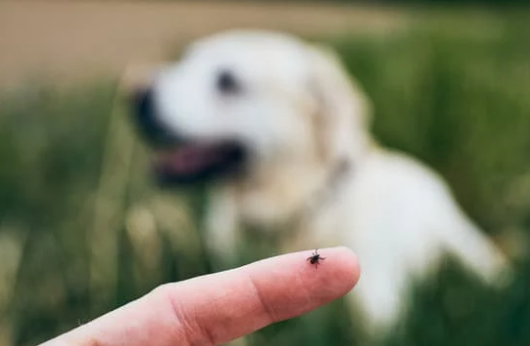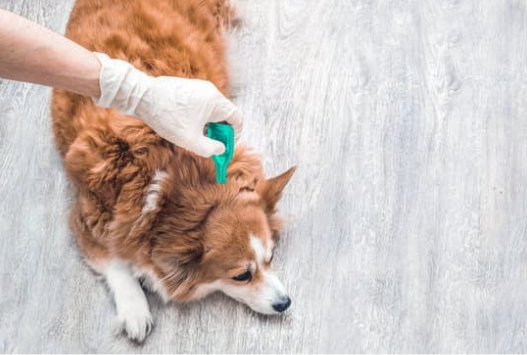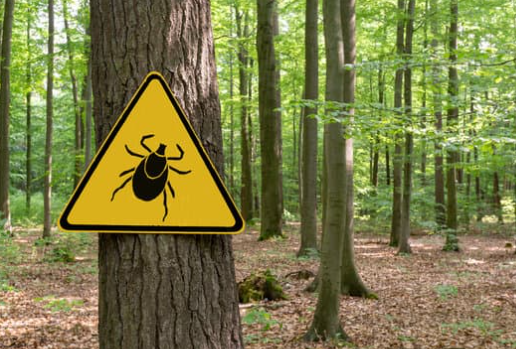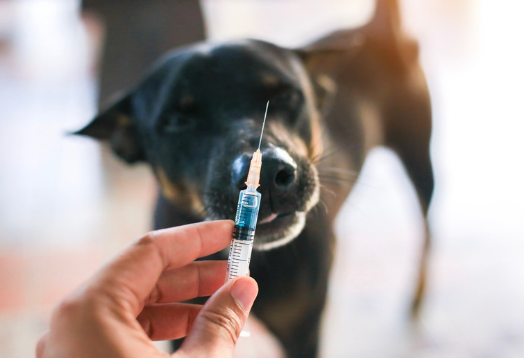Did you know about 50% of canines are infected with Lyme disease every year, often leading to fatal illnesses such as kidney failure, cardiac problems, and even death?
Therefore, Lyme disease is a common bacterial infection that can pose a threat to your beloved furry friends, requiring an efficient treatment.
Protect your dogs from Lyme disease by checking your dog for ticks, using tick preventatives, maintaining a tidy lawn, vaccinating for Lyme disease, maintaining good hygiene, and staying away from tick-infested regions.
Read further to get an idea about protecting your dog from seasonal pests.
What Is Lyme Disease?
Lyme disease is a zoonotic bacterial infection common in dogs and can cause fatal illnesses such as kidney failure and cardiac problems.
Ticks are most active in hot and humid conditions, especially during the spring, summer, and fall seasons.
However, black-legged ticks can remain active in temperatures above freezing, and deer ticks are prevalent in many areas nationwide.
This bacteria can survive in various hosts, including humans, animals, and birds; hence your pet is not safe unless you protect them.
How Does Lyme Disease Occur?
It spreads through the bites of ticks, specifically the black-legged or deer ticks that carry the spirochete bacteria Borrelia burgdorferi.
It takes approximately 24-48 hours for the Borrelia burgdorferi bacteria to migrate from the tick’s gut to its salivary glands and then be transmitted to the pet through the tick bite.
Therefore, quick removal of ticks before the infection time can help prevent transmission of the bacteria.
Symptoms of Lyme Disease in Dogs
- Early signs of Lyme disease include fever and loss of appetite. Your dog may start showing lethargy and not want to engage in usual activities.
- It gradually advances to limping and difficulty walking due to joint pain and inflammation as their joints become swollen and painful, particularly in the legs.
- The condition worsens when the lymph node enlarges and becomes tender to touch, eventually leading to kidney failure or heart disease if left untreated.
Tips to Protect Your Dog from Lyme Disease
Here are some handy tips for ensuring the safety of your furry friend this season.
1. Check Your Dog for Ticks Regularly
Ticks can cause serious health problems and even be fatal to dogs as they transmit deadly diseases like Rocky Mountain spotted fever, Lyme disease, and Ehrlichiosis.
Early detection and treatment are crucial in managing these illnesses.
Moreover, regular grooming and checking dogs for ticks can help prevent infestations. It also reduces the risk of human exposure to tick-borne diseases.

Things to Consider While Checking for Ticks
- Check your dog for parasites and ticks after every outdoor activity.
- Check areas where ticks attach themselves, including the ears, head, neck, armpits, groin, and between the toes.
- Look for minor bumps or rashes on the skin.
- Use a tick removal tool to grasp the tick directly by its head.
- It will be best if you gently pull it straight out steadily.
- Avoid twisting or squeezing the tick to reduce the risk of disease transmission.
- After removing the tick, sanitize the area with an antiseptic.
2. Use Tick Preventatives
Tick preventatives such as collars, topical treatments, or oral medications can kill ticks on contact or repel them by preventing them from attaching to your dog.
Topical preventives such as Frontline Plus, Advantage II, K9 Advantix II, etc., can clear dogs with current flea loads in 12-48 hours.
Similarly, oral preventives work within the first two to four hours, like NexGard Chewables, Bravecto Chews, Simparica Trio Chewable, etc.
Choose a veterinarian-recommended product that is safe for your animal and other pets in the household.

Things to Consider While Using Tick Preventives
- Use environmental protection agency (EPA) registered products.
- Read the labels carefully before applying sprays and giving oral medications.
- Be cautious with dosage.
- Consult with your vet before applying any tick prevention for your dog.
- Monitor your dog for any adverse reactions.
- Do not use human products.
3. Maintain a Tidy Lawn
Ticks survive in tall grass and overgrown vegetation. By keeping your lawn well-maintained and trimming any leafy plants, you can significantly reduce the number of ticks in your yard.
Ticks are also attracted to moist environments, so ensuring the lawn is well-drained can make it less appealing to ticks.
Keeping the lawn tidy and well-maintained is essential in preventing tick infestations and reducing the risk of tick-borne illnesses for dogs.

Things to Consider While Cleaning Your Lawn
- Mow your lawn regularly.
- Remove leaf litter and debris.
- Trim bushes and shrubs.
- Build a fence or barrier around your lawn.
- Use tick and flea repellents around plants and bushes.
- Place wood and other damp materials in a dry place.
During the spring and summer seasons, it is best to mow your lawn once per week; however, during the dormant season, like autumn and winter, mow it less regularly.
4. Avoid Tick-infested Regions
One way to reduce the risk of exposure to ticks is to avoid tick-infested areas.
Ticks are common in wooded areas, tall grasses, and other outdoor environments where they can attach themselves to dogs as they pass by.
Once attached, they can transmit various diseases, causing symptoms ranging from slight discomfort to severe illness and even death.

Things to Consider While Taking Your Dog Out
- Check your dog for ticks after roaming out.
- Keep your dog away from other animals.
- Use a flea comb regularly.
- Stick to well-maintained trails and paths when walking your dog.
- Avoid tall grasses and wooded areas.
- Check your dog’s ears, armpits, and groin occasionally.
Some of the most high-risk areas for ticks include the Northeast, Mid-Atlantic, and upper Midwest regions, including New Hampshire, Massachusetts, Connecticut, New York, Pennsylvania, New Jersey, Minnesota, and Wisconsin.
Ticks mostly prefer temperatures above 45°F and high levels of moisture. However, they can sustain in cool temperatures too.
There are several alternative outdoor activities for pets to reduce exposure to ticks. For example, instead of hiking in wooded areas, you can take your dog to a well-maintained dog park, a city park, or a paved trail.
5. Vaccination
Lyme disease vaccine, also called Nobviac Lyme, helps to protect your dog from the disease, but it is not 100% effective. So, using it conjointly with other preventative measures will be best.
Initially, the vaccine is administered in a two-shot series followed by annual booster shots.
It will be best to consult with your vet to determine the most appropriate timing to administer a booster dose for your dog.

Tips to Take Care of Your Dog Post Vaccination
- Let your dog rest in a warm and cozy place.
- Keep food and water accessible.
- Avoid patting and playing as soon after vaccination.
- It will be best to provide them with a peaceful place to avoid noise and distractions.
- If your dog shows any allergic reaction, contact your vet immediately.
6. Maintain a Clean Hygiene
Dog owners should also maintain a clean living environment by vacuuming regularly, washing bedding, and periodically washing toys and accessories.
It can help to prevent the spread of ticks and other parasites.
You should bathe your dog once per month in spring and summer with a shampoo specifically formulated for pets, like Veterinary Formula, Arm & Hammer, Burt’s Bees, etc., and grooming weekly with pet-safe tools will be best.

Moreover, it will help if you also examine yourself and your dog for tick traces after being outside. It involves looking for ticks attached to your skin or clothing.
Tips for Pet Owners to Remain Tick-free
- Showering after coming from outdoors.
- Use tick repellents around the home like Cedar oil spray, Eucalyptus oil, vet’s best spray, etc.
- Wear long-sleeved clothing while going out.
- Avoid tick-infestation areas during spring and summer.
- Check your children’s bodies after coming from walks.
Lyme disease occurs in humans also, and it takes 36-48 hours for infection to start after a tick bite, where some common symptoms include rashes and itching sensation, fever, headache, fatigue, erythema migrans, numbness or tingling in hands or feet, heart palpitations, and arthritis.
Lyme disease in humans is treated with antibiotics.
- Oral antibiotics such as doxycycline, amoxicillin, cefuroxime axetil, etc., are prescribed for early-stage Lyme disease.
- Similarly, intravenous antibiotics like Ceftriaxone, Penicillin G, Doxycycline, Azithromycin, etc., can eliminate later-stage problems like joint pain, neurological problems, and heart palpitations.
Treatment for Lyme Disease
Early diagnosis and treatment are crucial for preventing serious complications of any disease. The treatment of tick-borne illnesses like Lyme disease typically involves an antibiotic course.
However, the treatment duration depends on the disease’s stage and severity.
- Antibiotics: The primary treatment for Lyme disease in pets is a 30-day course of antibiotics prescribed by a veterinarian. The length of treatment commonly lasts for a month.
- Pain management: Pets with Lyme disease may experience severe joint pain and discomfort. Consult with your veterinarian to ask for pain relievers or anti-inflammatory medication to manage these symptoms.
- Supportive care: Your pet requires supportive care such as rest, hydration, and a nutritious diet besides medication. Ask your vet for guidance on supporting your pet during their recovery.
- Infection prevention: To prevent further infection, you should use medications recommended by your veterinarian.
However, prevention is better than cure. So, as a responsible pet owner, taking precautions to protect your dog from Lyme disease will be best.
Conclusion:
Some other diseases, such as Ehrlichiosis and Rocky Mountain spotted fever, seasonal allergies, and heartworm disease, show similar symptoms to Lyme disease.
The best approach would be to diagnose Lyme disease with C6 and Quant C6 blood tests to detect antibodies against Lyme infection.
These tests will help determine whether your dog is suffering from Lyme disease and their necessary antibiotic treatment plan.
Talk to our certified veterinarian to use the best form of tick prevention for your pup. Moreover, if your pet shows symptoms of distress due to tick infection, contact the best pet hospital in Urbandale, Urban Pet Hospital, immediately.